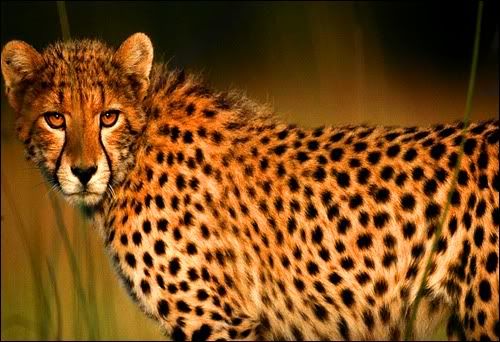|
|
Cheetah
May 15, 2009 18:43:10 GMT -5
Post by Revenge on May 15, 2009 18:43:10 GMT -5
Cheetahs
Built for Speed: The cheetah can reach speeds of 68 mph, making it the fastest land mammal in the world. It has nonretractable claws (unlike those of other cats), which provide it with better traction when it runs on soft ground. Unlike most large cats, which hunt by ambush, the cheetah chases its prey at high speed, using its tail as a stabilizer, especially when making tight turns.
Cheetah Habits: It preys on many of the animals that share its habitat, including gazelles, gnus, antelopes and warthogs. The males often live in small groups; the females are solitary, meeting up with males only to mate.
Under Threat: Once hunted for its spotted coat, the cheetah is now protected. However, poaching and habitat destruction continue to threaten it.
DID YOU KNOW?
The Spotted One: The word "cheetah" comes from the Indian word for "spotted one."
Born Gray-Blue: A cheetah cub is born with a long, gray-blue coat and a black belly. These may help keep the cub better camouflaged when it's lying still in the long grass.
Cheetah Talk: The cheetah's most common call is a birdlike chirp, such as when calling to its young. It also yelps when excited, hisses and snarls when agitated and purrs when content.
Cheetahs as Pets?: In Sumerian, Egyptian and other ancient civilations, cheetahs were frequently kept as pets. In fact, as hunting companions they may once have been as popular as dogs.
[/blockquote] |
|
|
|
Cheetah
May 15, 2009 18:52:15 GMT -5
Post by Revenge on May 15, 2009 18:52:15 GMT -5
The Cheetah
Cheetah Profile
The cheetah is the world's fastest land mammal. With acceleration that would leave most automobiles in the dust, a cheetah can go from 0 to 60 miles (96 kilometers) an hour in only three seconds. These big cats are quite nimble at high speed and can make quick and sudden turns in pursuit of prey.
Before unleashing their speed, cheetahs use exceptionally keen eyesight to scan their grassland environment for signs of prey—especially antelope and hares. This big cat is a daylight hunter that benefits from stealthy movement and a distinctive spotted coat that allows it to blend easily into high, dry grasses.
When the moment is right a cheetah will sprint after its quarry and attempt to knock it down. Such chases cost the hunter a tremendous amount of energy and are usually over in less than a minute. If successful, the cheetah will often drag its kill to a shady hiding place to protect it from opportunistic animals that sometimes steal a kill before the cheetah can eat. Cheetahs need only drink once every three to four days.
Female cheetahs typically have a litter of three cubs and live with them for one and a half to two years. Young cubs spend their first year learning from their mother and practicing hunting techniques with playful games. Male cheetahs live alone or in small groups, often with their littermates.
Most wild cheetahs are found in eastern and southwestern Africa. Perhaps only 12,000 of these big cats remain, and those are under pressure as the wide-open grasslands they favor are disappearing at the hands of human settlers.
Cheetah Range (In the yellow)
Fast Facts
Type: Mammal
Diet: Carnivore
Average lifespan in the wild: 10 to 12 years
Size: 3.5 to 4.5 ft (1.1 to 1.4 m); Tail, 25.5 to 31.5 in (65 to 80 cm)
Weight: 77 to 143 lbs (35 to 65 kg)
Protection status: Endangered
Size relative to a 6-ft (2-m) man
|
|
|
|
Cheetah
May 15, 2009 18:52:42 GMT -5
Post by Revenge on May 15, 2009 18:52:42 GMT -5
|
|





